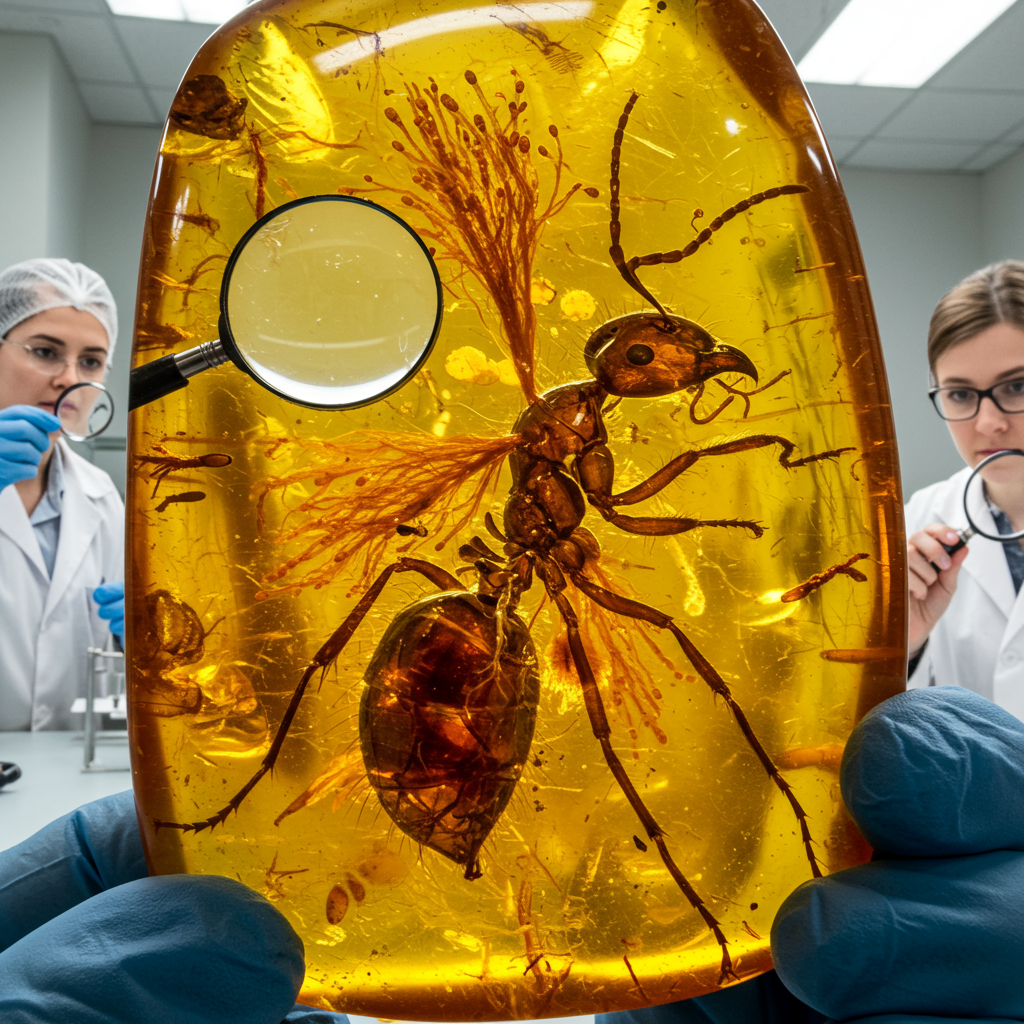Unlocking secrets hidden for nearly 100 million years, recent fossil discoveries in amber are revolutionizing our understanding of parasitic fungi. these remarkable finds provide the oldest direct evidence yet of complex relationships between fungi and insects. They specifically point to the ancient origins of the notorious Ophiocordyceps group. This is the same genus that inspired the frightening fictional fungal infections seen in “The Last of Us.” The findings push back the known evolutionary timeline for these remarkable organisms by tens of millions of years.
Entomopathogenic fungi possess incredible, sometimes disturbing, abilities to manipulate their insect hosts. Among the most well-known are the “zombie-ant fungi” (Ophiocordyceps unilateralis). These fungi specifically target carpenter ants in tropical regions. Once infected, the fungus invades the ant’s body and subtly takes control of its nervous system.
The infected ant is compelled to leave its colony, often climbing vegetation to a precise height. It then performs a chilling “death grip,” biting fiercely onto a leaf or stem. This fatal act secures the ant in place as the fungus consumes its tissues. Finally, a stalk emerges from the ant’s head. This structure releases infectious spores down onto the forest floor, ready to infect new victims. This macabre cycle ensures the fungus reproduces effectively from an optimal elevated position.
Beyond the Ant: Other Manipulated Hosts
While zombie ants are famous, fungi employ similar tactics on other insects. In grasslands, species like Entomophthora grylli cause “summit disease” in grasshoppers and crickets. Infected individuals climb to the tops of plants and perch conspicuously before succoreleasing spores.
Some related fungi even compel hosts to find watery graves. They drive insects to wander into streams or ponds. Drowning ensures the fungus can grow in the moist conditions it requires.
Houseflies aren’t safe either. Entomophthora muscae infects flies, driving them to high points like walls or windows. The fly glues itself down before the fungus erupts, radiating spore-laden filaments to infect other flies nearby. Even spiders fall prey. Some Ophiocordyceps species force spiders to attach themselves to surfaces, providing a platform for spore dispersal.
These diverse strategies highlight fungal evolution’s astonishing adaptability. By subtly rewriting their hosts’ behavior – climbing, gripping, navigating – these fungi orchestrate perfect conditions for their reproduction. What looks like suicidal behavior by the insect is a precisely executed strategy by the parasite.
The Challenge of Finding Ancient Fungi
Direct fossil evidence of these intricate relationships is incredibly rare. Fungal tissues are typically soft and decay quickly. It’s difficult for them to survive the millions of years needed for fossilization. Identifying parasitic behavior in ancient insect remains is also challenging. Previous understanding of Ophiocordyceps evolution relied heavily on indirect evidence and limited fossil data, some dating only to around 50 million years ago. Finding well-preserved specimens showing the fungus interacting with its host has been a major hurdle.
A Glimpse into the Cretaceous: The Amber Discovery
That’s what makes a recent discovery so significant. Researchers, including a team led by Yuhui Zhuang of Yunnan University and involving experts like Professor Edmund Jarzembowski from the Natural History Museum in London, examined remarkable fossils. They found two insects infected by ancient fungi preserved in mid-Cretaceous Kachin amber from Myanmar. This amber dates back approximately 99 million years.
Using advanced techniques like optical microscopy and micro-computed tomography (3D X-ray imaging), scientists meticulously studied the specimens. They identified two previously unknown ancient fungal species. One, found emerging from a young ant pupa, was named Paleoophiocordyceps gerontoformicae. The ant host belonged to the extinct genus Gerontoformica. The second species, Paleoophiocordyceps ironomyiae, was discovered on a fly.
The preservation was exceptional, capturing the fungi growing directly from their hosts’ bodies. This provided invaluable direct evidence of ancient parasite-host interactions. It offered a unique window into a world teeming with life, including complex parasitic relationships, during the age of dinosaurs.
What These Fossils Revealed
The morphological features of Paleoophiocordyceps species bore striking similarities to modern Ophiocordyceps. For instance, P. gerontoformicae displayed traits seen in existing myrmecophilous (ant-loving) Ophiocordyceps. However, the ancient fossils also showed unique characteristics. P. ironomyiae showed a fungal fruiting body emerging from the fly’s head, similar to modern infections. But its tip was unexpanded and textured, unlike the smooth, swollen tips common today. Even more surprisingly, P. gerontoformicae was erupting from the ant pupa’s metapleural gland, a location never observed in modern Ophiocordyceps.
These distinct features confirmed they were ancient, separate species. By comparing their structures to living Ophiocordyceps and using genetic data from modern relatives, the research team placed the Paleoophiocordyceps species within the Ophiocordyceps lineage. Their phylogenetic analysis estimated the genus Ophiocordyceps likely originated much earlier than previously thought, around 133 million years ago, during the Early Cretaceous.
Evolutionary Host Shifts
The study’s findings shed light on how these parasitic fungi evolved. Ancestral reconstructions suggest that the Ophiocordyceps lineage likely began by parasitizing beetles. Beetles were diversifying during earlier periods, offering ample hosts. Over time, the fungi underwent significant host shifts. By the mid-Cretaceous, they had evolved to infect other groups, including Lepidoptera (moths and butterflies) and Hymenoptera (ants, bees, wasps).
Researchers propose these transitions coincided with the diversification of these insect groups. As new potential hosts like ants and moths became more abundant, it created new ecological opportunities. This spurred the fungal lineages to specialize and adapt to exploit these new insect populations, leading to the variety of Ophiocordyceps species we see today.
The authors concluded that these remarkable fossils not only provide some of the earliest direct evidence of insect-pathogenic fungi but also strongly support the idea. They believe Ophiocordyceps diversified and evolved alongside the explosion in diversity of their insect hosts millions of years ago. This highlights a fascinating evolutionary arms race present long before humans existed.
Ancient Ecological Role
The lethal nature of these ancient fungal infections suggests Paleoophiocordyceps likely played a crucial ecological role. Similar to how modern Ophiocordyceps can significantly impact insect populations, these ancient parasites were likely key regulators of ants and flies during the mid-Cretaceous. They contributed to the balance of ecosystems millions of years ago.
While the fossils confirm the ancient existence of these parasites infecting ants and flies, direct evidence of the behavior manipulation itself is still rare. The oldest fossil evidence of the specific “death grip” bite mark on a leaf is currently from the Eocene period, around 48 million years ago. Scientists are now keen to examine Cretaceous-era leaves for similar bite marks. Finding these could push back the known origins of this complex mind-controlling behavior even further into the past.
This discovery underscores the long and complex co-evolutionary history between fungi and insects. It provides a rare glimpse into the deep past of parasitic relationships. It confirms that some of nature’s strangest phenomena have roots extending back to the age of dinosaurs. The study, published in Proceedings of the Royal Society B: Biological Sciences, offers valuable insights for mycologists and entomologists alike. It reveals the remarkable adaptability of these ancient life forms.
Frequently Asked Questions
Are ancient zombie fungi the same as modern ones?
The ancient fungi discovered in amber, Paleoophiocordyceps gerontoformicae and Paleoophiocordyceps ironomyiae, belong to the same evolutionary group (genus Ophiocordyceps) as the modern “zombie-ant” fungi (Ophiocordyceps unilateralis). While sharing key characteristics, the fossil species had unique features, suggesting they were distinct ancient relatives that diverged over 130 million years ago.
What did the 99-million-year-old amber fossils actually show?
The amber fossils contained two insect victims: a young ant pupa and a fly. Emerging from their bodies were well-preserved structures of ancient fungi. These structures showed where the fungi grew from the hosts, including a unique eruption point on the ant pupa’s metapleural gland. This provided direct proof of parasitic infection from nearly 100 million years ago.
How did these parasitic fungi evolve to infect different insects?
Researchers believe the Ophiocordyceps lineage initially parasitized beetles. As other insect groups like ants and flies diversified and became abundant during the Cretaceous period, the fungi underwent “host shifts.” They evolved the ability to infect these new hosts, specializing and expanding their ecological niches alongside the rising diversity of their insect prey.
This groundbreaking research, published in Proceedings of the Royal Society B: Biological Sciences, relies on careful human analysis and provides deep insights into Earth’s ancient ecosystems. Support for independent science reporting helps bring these significant discoveries to light.




